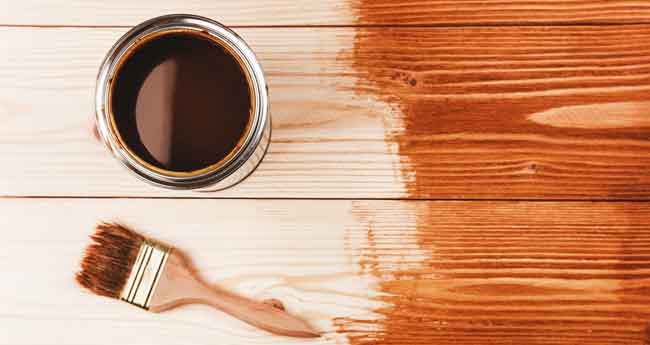Confused! which sort of timber discolor you should make use of in your job?
No concerns! Our specialists exist to provide you a correct service worrying this trouble!
A timber discolor is made use of to shade timber, alter its look, or to improve its grain. Discolorations resemble paints as well as include 3 exact same cornerstones pigment, service provider or solvent, and also a binder.
They not just provide a remarkable as well as appealing want to a timber look yet likewise secure versus warm, mold and mildew, and also various other chemical spills.
Several timber discolorations are readily available, timber spots including pigments as well as timber spots that are dyes liquified in a solvent. This solvent is frequently called as an automobile. Popular solvent( automobile) are polyurethane, lacquer, varnish, and also shellac.
If you are a novice at woodworking after that you may be bothering with which tarnish kind to utilize. There is every factor to question prior to picking a timber tarnish as timber itself is a really gorgeous product and also have various kinds. Antiques, woods, softwoods they all call for a various kind of timber tarnish.
Wood spots can do marvels by making brand-new timber resemble old timber and also an old timber appear like an extremely uncommon timber. To much better comprehend the residential or commercial properties of timber discolor, allow us talk about of each kind.
Different Types of Wood Stain and also Their Uses
1. Oil-based Wood Stain
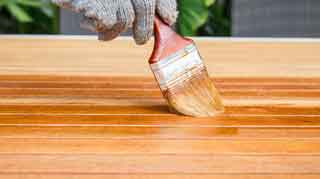
The most preferred timber discolor is an oil-based discolor. It is as a result of its deep infiltration and also toughness. Numerous oil spots include linseed oil with varnish.
Linseed oil is an all-natural and also non- harmful oil as well as it is just one of the very best chemicals for any type of timber surface or timber paint. An oil-based discolor can be conveniently recognized since of its thinning by mineral spirits.
Mineral spirit made use of in the production of an oil discolor is a solvent commonly detailed as “oil distillates” in much prominent timber discolor summary. Aliphatic hydrocarbon is one more alternate name for mineral spirit made use of in oil tarnish.
Some oil discolorations likewise consist of artificial pigments usually iron oxide pigments as well as dyes and also can be described as “cleaning discolorations”. Some can additionally consist of just color. Industrial oil spots likewise include a 3rd component “binder”. Binder can be any type of type of material and also it assists in binding the pigments to a timber surface area.
Many oil discolor producers utilize linseed oil as a binder after treating it with numerous unique acids to avoid it from permeating deeply right into the timber.
A thickening representative is additionally included in numerous oil-based discolorations. Suppliers do not provide this as it can be exclusive. The thickening representative additionally aids an oil discolor to manage its infiltration.
While choosing natural oil-based it is very important to examine active ingredients of that specific timber tarnish. You can pick an oil tarnish under any kind of sort of timber coating after understanding its compatibility with your timber however prevent utilizing it prior to a water-based surface.
An oil discolor takes practically 2 -3 hrs to completely dry. It is recommended that delay 3 hrs prior to using an additional layer of tarnish as well as 9-10 hrs prior to using a timber surface. Constantly completely dry it under area temperature level.
These are a few of the advantages and disadvantages of utilizing an oil-based discolor.
Pros
- An also coating
- Deeper Penetration
- High longevity
Cons
- Slow drying out Process
- Mold qualified
2. Water-Based Stain

Water-based spots are normally made use of under a water-based discolor. As a thinner, it makes use of water as opposed to natural slimmers. It additionally has water-soluble aniline dyes to hand down shade.
Water-soluble aniline dyes are chemically acquired dyes. These dyes are great powder stemmed from coal tar as well as use a large amount for colorfastness when liquified in water.
Water-based discolorations are extremely eco-friendly and also include much less contaminated bits. Water-based spots do not create any kind of unstable natural substances. These discolorations high-grade pigments that boost the grain of the timber.
Water-based spots are usually challenging to make use of due to the fact that they dry out really rapidly. To use it equally on a large surface area, woodworkers separate this application right into brief time sections.
To conquer its fast-drying nature, numerous woodworkers include a slow-moving vaporizing solvent such as propylene glycol or lacquer retarder right into it however this decreases the discolor shade and also protests the primary function of making use of a water-based discolor.
Wood surface area prep work is extremely vital prior to utilizing a water-based tarnish. Tidy up the surface area prior to using as well as ensure that there is no dirt bit on it. Currently damp the timber and also leave it over night. Currently smooth the surface area by fining sand off any type of surface area roughness. Use the initial layer of water-based tarnish.
Overall, using water-based discolor is really time consuming is popular for boosting the timber grain. They do not deeply pass through the timber as well as hence not provide great security for your timber.
The adhering to are several of the advantages and also disadvantages of water-based discolor.
Pros
- Speedy drying out
- Capable of opposing mold
- An environmental-friendly tarnish
Cons
- Time-consuming
- Low infiltration
3. Gel Stain
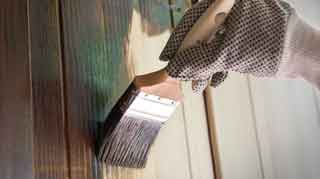
Manufacturing of gel spots was begun in the late 20 th century. A gel discolor is a high-viscosity fluid as well as is preferred as a result of its thick pigments. These pigments exist in the jelly kind kind.
This maintains a gel tarnish to continue to be also as well as to not move or leakage as various other spots do. It is really valuable while using tarnish as well as offer control of its use. Also when the timber remains in upright form, this tarnish will certainly not flooring or drip as contrasted to numerous various other timber discolorations.
However, gel spots usually posses really minimal permeating ability as a result of thixotropic nature. Thixotropic can be described as a fluid that does not move.
Their distinct residential or commercial property to function uniformly on both permeable and also impermeable timber make them excellent discolor while dealing with various kinds of timber. Mainly gel spots are either oil-based discolorations or they can be varnish based discolorations.
A fine-grained enlarging representative is blended with a fluid combination of materials, mineral spirits, or pigments to make a gel discolor. Application as well as use of these spots are extremely simple as well as foreseeable. These discolorations are especially prominent when with a want discoloring task.
Before using any kind of gel tarnish constantly examine an example of it on your timber to accomplish the very best outcomes. Constantly tarnish in an effectively aerated location and also usage handwear covers. Use a layer of gel discolor by utilizing a cloth in a round activity. After using, clean any kind of too much gel discolor.
Pros
- Good Hiding Quality
- Easy application
- No Dripping
- No requirement for fining sand
Cons
- Slow drying out discolor
- Can not be splashed
4. Lacquer Wood Stain
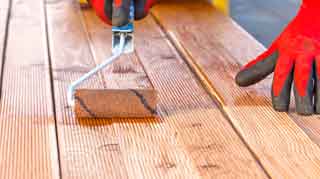
Lacquer spots are popular amongst specialist woodworkers it is since they can be used really promptly. They contain some fast-drying varnish mainly xylene and also ketones. Xylene and also ketones can be combined with a lacquer to create a pigmented lacquer.
Mostly, lacquer timber spots do not include any kind of lacquer in it yet simply these fast-drying spots as well as are called as lacquer discolorations.
These fast-drying spots simply require just 15 mins to obtain completely dry. Different ketones as well as xylene have a really solid bitter smell and also because of these, they can be conveniently recognized. This smell is as a result of the really quick evaporation of these solvents.
Lacquer spots are it thinner making them conveniently permeate timbers and also do not require greater than 2 finishes. Occasionally while utilizing a lacquer tarnish, bubbles can show up on your timber surface area. It primarily takes place due to the fact that lacquer catches air bubbles while drying out quick. To prevent it, attempt to manage the area temperature level or attempt to slim it with lacquer thinner.
Always put on a safety and security mask prior to using lacquer spots. Pick a lacquer discolor if you are an expert as well as have really little time for discoloration.
Pros
- Fast completely dry
- Easy application
Cons
- Bubbles
- Discoloration in time
5. Water-Soluble Dye Stain
These discolorations constantly are available in powder type so it is extremely simple to determine them. These spots were popular prior to the innovation of steel complicated dyes. They are still commonly made use of since of different shades selection and also splendor.
They are frequently called aniline dyes as well as were to start with made use of for fabrics in the late 19th century. To make a fluid kind of water-soluble color tarnish, merely blend it with water. Include one ounce of powder in one quart of water option. This is the basic proportion for it. To make a much more extreme shade, include even more powder in the mix.
It is advised to utilize pure water for making this remedy as there can be metal deposit in water which can impact the shade uniformity of these spots.
This tarnish will certainly not conceal a timber entirely regardless of the number of layers are used. It will certainly keep the all-natural appeal of the timber. These spots do not include any type of binder as well as can be conveniently dimmed or lightened after using.
However, these dyes have a tendency to discolor under sunlight direct exposure due to UV-rays. One of the most frequently utilized sorts of these discolorations are alcohol soluble and also oil-soluble dyes. An oil-soluble color can be combined with an oil discolor.
Always pick a water-soluble color for tarnishing to have optimal control over tarnish after using.
Pros
- Verity of shades
- Will not cover timber
- Easy upkeep
Cons
- Fade under UV direct exposure
6. Metalized Dye Stain
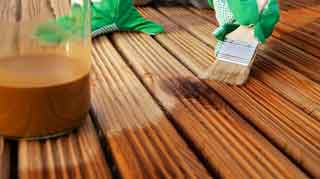
These sorts of discolorations are best while dealing with bare timbers. They are likewise called understand grain increasing spots (NGRS).
They are non-grain elevating spots as they are quickly liquified in rapid vaporizing solvents and also supplies a great deepness of shade. They were presented in the 1950 s and also were called as metal facility spots.
They prepare to utilize discolorations liquified in glycol ether combined with ethanol, methanol, as well as occasionally with retarder. One of the most prominent trademark name for making these timber spots are ultra permeating tarnish, super-penetrating spots, as well as Solar-Lux.
These dyes are additionally offered in focused type as well as can be quickly thinned with water, alcohol, or any kind of lacquer thinner. For focused spots, they are prominent with Trans Tint and also Wizard Tints brand names.
For the application of these spots, constantly utilize a sprayer. If it dries out as well quickly, include 10% of any kind of objective made retarder to tarnish as well as reduce the drying out time. Utilize a smooth damp fabric to also out this tarnish.
Pros
- Best for bare timbers
- Resist Fading
Cons
- Dry also quickly
7. Varnish Wood Stain
Varnish discolorations are extremely comparable to oil-based timber discolorations. These discolorations just consist of varnish as a binder. It can likewise be a polyurethane varnish.
Polyurethane is a man-made material as well as can be in the type of fluid plastic. Polyurethane varnishes are warmth immune as well as provide a solid resistance versus acid as well as chemical spills.
These discolorations completely dry difficult which suggests that they can quickly keep also uniformity of shade on a timber surface area as it solvent parts vaporizes totally et cetera of it polymerize to make a sturdy layer over timber. Varnish spots likewise utilize the exact same thinning product oil distillates similar to oil discolorations.
The large factor behind brand names classifying both discolorations in different ways is the distinction of binder. With varnish timber discolor, there is no requirement to make use of an ending up layer as it develops a safety and also solid layer on timber that can not be quickly broken.
The large downside of making use of varnish timber tarnish is that it can look still look splotchy and also will certainly need even more layers to make it also.
Varnish discolorations are recommended for a tiny woodworking task and also if you are collaborating with a currently tarnished or worn timber surface area. Varnish can be used with a roller or a brush. Apply towards the timber grain.
Pros
- Natural appearance
- Hard completely dry
- Protection from dust as well as water
Cons
- Yellowish with time
- Bubble development
What Kind of Stain Need to Use on Different Types of Wood Surface/Material?
Choosing a discolor thoroughly prior to beginning your job will certainly conserve you from the problem of redesigning the entire procedure once more.
If you are preparing to discolor your wood furnishings, closets, floorings, or various other surface areas, it is necessary to understand which kind of discolor will certainly function according to your timber layout.
1. Wood Furniture
While dealing with wood furnishings, the choice of a tarnish that will certainly offer your furnishings a sensational appearance is complicated. You can totally transform the last appearance of your wood furnishings by picking a various kind of spots. Some discolorations will certainly provide your furnishings an all-natural appearance while others will certainly offer your furnishings a classy antique appearance.
To offer your furnishings a troubled appearance, utilize an oil-based tarnish. This discolor will certainly provide your furnishings that trendy appearance you desire. As an oil-based tarnish will certainly constantly leave your furnishings surface area smooth, it is suggested for wood chairs, tables.
This tarnish is solid and also it is extremely much less most likely to damage when utilizing on furnishings like chairs legs, table, and so on
Apply an ending up layer of polyurethane over the tarnish as well as this gives an additional safety layer for your wood furnishings while providing it a brand-new troubled appearance.
You can additionally make use of an acrylic tarnish on your furnishings. It will certainly likewise leave the surface area smooth and also soft. Maintain in mind this kind of tarnish will certainly take a lot longer to completely dry as well as can be costly.
2. Wood Cabinets
Now, if you intend to choose a great tarnish for your closets in the bathroom and kitchen, you need to be extremely mindful regarding various aspects as a result of special problems. Wetness material is high in the kitchen area as well as it does not stay continuous as a result of numerous cooking features.
A washroom likewise handles a great deal of shower vapor and also dampness. Wood cupboards in both locations are extremely most likely to establish mold.
Considering all these variables, pick a tarnish that has a high ability of mold resistance. We will certainly recommend you choose an oil-based discolor as it will certainly not take in water.
Use an oil-based tarnish in a semi-gloss to produce an also look. Because of the level of smoothness of this tarnish, it will certainly be simple to clean up any kind of dirt or food bits from the closet.
However, if you are seeking to discolor the inside of your wood cupboards, utilize a satin luster tarnish to stop dampness on racks. If you are intending to tarnish closets in other places in your house, utilize a latex tarnish to offer your timber all-natural as well as glossy appearance.
3. Wood Floors
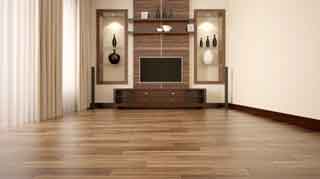
You need to think about a great deal of variables while discoloring a wood flooring. A tarnish must suffice solid to deal with everyday footwear web traffic, leaking umbrellas, as well as hurrying various other sort of hefty product over your timber flooring.
It can be harmed by numerous various other concerns like if you are changing your furnishings or couches from one side to an additional.
A latex tarnish is the most effective selection for discoloring a wood flooring. Utilize this discolor in gloss or a semi-gloss to leave your timber smooth, level, and also simple to wipe.
An oil-based- discolor is likewise an excellent choice for discoloring your timber flooring. You can utilize polyurethane to topcoat your oil-based discolor. It will certainly protect timber versus any type of dirt fragment. Bear in mind If you are utilizing polyurethane, permit it to completely dry for a longer duration. Or else, your timber surface area will certainly be sticky.
4. Wood Trims
Selecting an oil discolor is the most effective selection when functioning with indoor trims like door coverings. As oil spots will certainly provide high toughness versus any kind of scuff marks. This tarnish is likewise extremely simple for normal cleansing and also does not leave a surface area sticky.
If you have attractive as well as trendy trims or you are dealing with complicated styles in circles, choose a latex discolor. This tarnish will quickly enter into every component and also supply complete insurance coverage for your layout. Select a level or satin latex as it will certainly provide a smoother insurance coverage and also will certainly not need you to cleanse it routinely.
Before beginning with discolor, preparing the surface area is perfect for the very best outcomes.
5. Bare Wood as well as Wooden Decks
While dealing with bare timbers as well as wood decks, it is necessary to utilize a pre-stain conditioner for your timber. Choosing a pre-stain conditioner relies on the sort of discolor that you will certainly be making use of.
The pre-stain will certainly enable your tarnish to obtain soaked up quicker, evenly, and also magnificently. Await at the very least 20 mins prior to using a tarnish. Get rid of any kind of excess pre-stain from timber.
Now mix your tarnish as well as be really mindful regarding air knickknacks as well as use your initial layer. You can utilize an oil discolor for your wood deck however severe weather can harm this discolor.
So, it is an excellent selection to pick an acrylic discolor over an oil tarnish. Polymer spots are particularly developed for outside problems as well as protect against wetness as well as mold and mildew.
6. Wood Knickknacks
Wooden showpieces frequently call for discoloration and also sort of discolor for this objective depends upon the dimension as well as range of the entire woodworking job. An oil discolor is finest if you are managing bigger and also large wood boxes or picture structures.
If you are dealing with smaller sized jobs like embellishing your little souvenir with various shades, A craft tarnish is suggested. To firmly secure the tarnish, you may wish to topcoat your timber with a polyurethane layer. Polyurethane finishing will certainly stop it from damages by making the external surface area solid.
7. Timber Ceiling Beams

Adding an excellent discolor to your wood ceiling light beams will certainly include attractive shade to an entire space. Including shades to your beam of lights by utilizing a discolor is extremely simple. For this function, utilize an acrylic-based tarnish.
Start this job on a completely dry day. Maintain your doors available to give all-natural air flow. An acrylic-based discolor will certainly offer your timber best defense versus dampness as well as is offered in various shades. You can likewise blend various shades of tarnish if you wish to offer your light beams even more of a creative appearance.
As there are various sorts of timber as well as every one has a various nature, they will certainly respond totally in a different way to a timber discolor. Softwoods over soak up the tarnish, and also woods do not take discolor extremely well.
Below is a contrast of timber for a tarnish job:
8. Pale Woods/ Pine Wood
Pale timbers like want and also poplar call for a really light covering of discolor. When you are dealing with a pinewood job or any type of various other softwood, it is suggested to utilize pigmented oil spots. These spots are best reliable while dealing with trim, racks as well as in, pricey furnishings.
As pigmented oil spots are non-penetrating they are not advised for woods. With oil-based discolorations, you can quickly provide your light timbers a cherry shade, and also oak shade, or any kind of various other costly timber shade.
Always attempt to use an extremely modest layer of oil-based tarnish on want timber. Prior to using, make use of a pre-staining conditioner and also pick in between light to tool tarnish.
9. Ashwood/ Hard Woods
If you are dealing with an oak and also ash timber, attempt to choose a tarnish that benefits woods. It is recommended to select in between light to darker tones.
One of the very best discolorations while collaborating with ash timber jobs is permeating oil-based tarnish. This sort of tarnish boosts the all-natural elegance of an oak or ash timber by developing amazing shades. An ashwood has huge pores as well as takes in discolor really conveniently.
You can regulate the strength of shade by the size of time you discolor your timber. Drying out time will certainly be longer than typical while collaborating with such kinds of tasks and also when completely dry these spots are really tough to eliminate. Attempt to clean out any type of unwanted of this discolor as quickly as you can.
10 Birchwood
This kind of timber is really tough to collaborate with tarnish. These birch timbers are more economical timbers than maple timber and also are typically utilized as an alternative for maple.
While dealing with birch timber, constantly pick a water-based discolor. As these timbers do not take discolor effectively and also tarnish absorption is unequal, water-based spots can be made use of for the very best feasible outcomes.
Apply a pre-stain timber conditioner prior to tarnishing your timber. Make use of a brush to use discolor and also do it in extremely also uniformity. Wait on your birch to completely dry. If the outcomes are not also, use printer toner on your timber.
11 Alder Wood
Alder timber is extremely simple to obtain stained in time. To prevent blotching, constantly pre-treat your alder timber. The most significant issue while collaborating with this sort of timber is that it takes in a timber tarnish in an irregular kind.
Any pigment kind discolor will certainly not saturate well in alder timber and also it is encouraged to utilize aniline dyes.
Apply a slim layer of these dyes on your timber as well as wait on it to completely dry prior to using any kind of additional layer to obtain a much better outcome.

Conclusion
We attempted to talk about different kinds of timber discolorations and also which one is ideal under various scenarios.
Commonly utilized timber spots are oil-based as well as water-based discolorations. Constantly evaluate an example of discolor that you are utilizing. Use it on an item of timber that you will certainly be utilizing for your job.
Wait for the tarnish to appropriately completely dry and after that observe the outcomes. By doing this, you will certainly constantly understand just how a particular tarnish will certainly deal with your timber.
Use handwear covers as well as masks and also attempt to prevent getting in touch with or absorbing any kind of timber discolor. It is a great technique to tarnish your wood things as it offers a long-term coloring to your timber by permeating it.
We really hope that with all the info, you will certainly handle to select the ideal discolor for your furnishings or any type of woodworking job.
.

